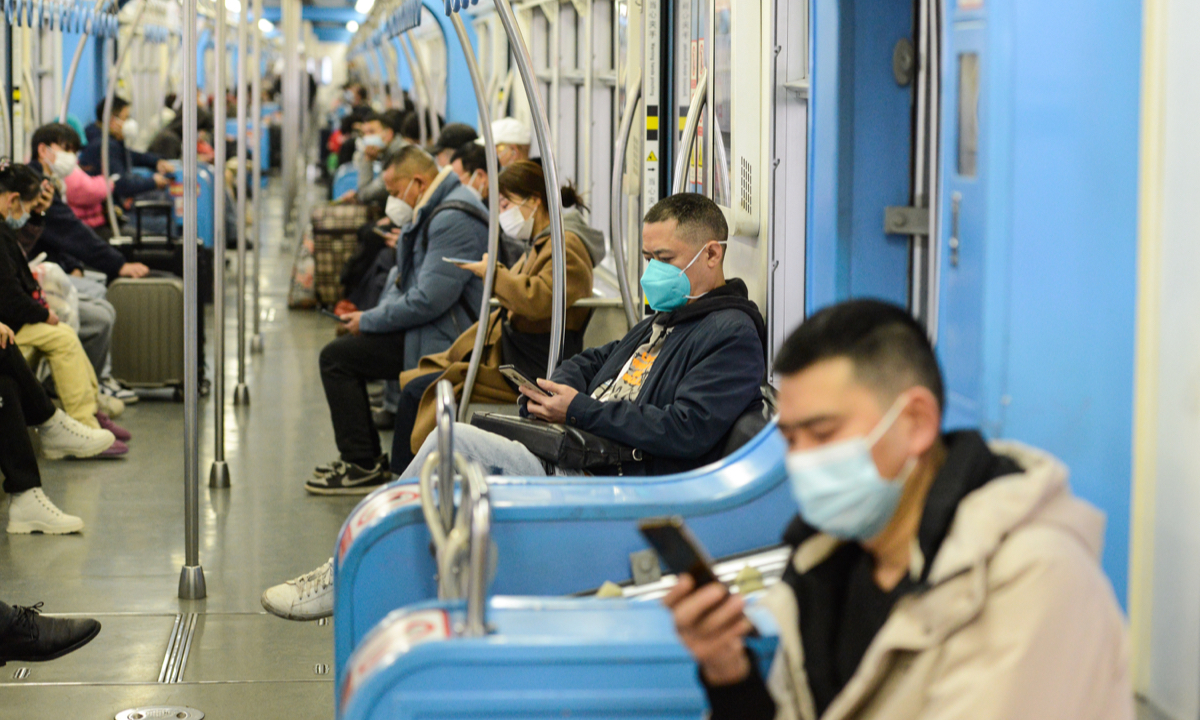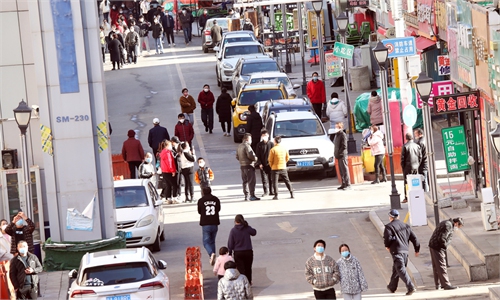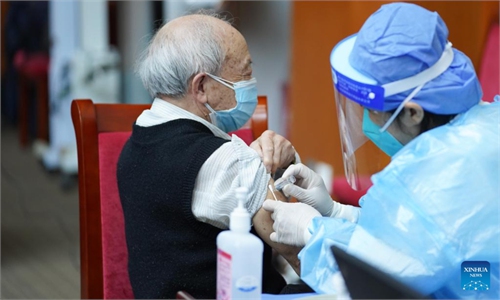At least 19 cities scrap tests to use public transit; experts explore necessity of downgrading COVID management
Latest moves to further optimize COVID response in new stage

Residents of Southwest China's Chongqing take the subway on December 5, 2022. The city resumed subway service from 6:30 am that day and residents needed only to present their green health code to access public transit services. Photo: cnsphoto
At least 19 cities across China scrapped negative nucleic acid test results as a requirement for riding public transport as of Monday, part of the country’s broader efforts to further optimize COVID-19 response in order to gradually resume social and economic activities.
Considering the weaker virulence of Omicron and that the majority of ongoing infections are mild or asymptomatic cases, Chinese public health experts are discussing the necessity of downgrading the management of the COVID-19 response, as China has always adjusted its epidemic policies in accordance with the changing situation with the aim of protecting its people at the maximum level.
Cities including Chengdu in Southwest China’s Sichuan, North China’s Tianjin, Beijing, Shenzhen in South China’s Guangdong, Shanghai and Wuhan in Central China’s Hubei, announced that local subways will no longer check passengers’ nucleic acid test results, according to media reports.
More than 10 cities and regions in East China’s Zhejiang ended regular mass testing, and local residents in cities like Hangzhou and Ningbo do not need to scan their nucleic acid codes or QR codes in public places, except in special locations such as elder care centers, kindergartens, primary and middle schools.
In Shenzhen, a city dubbed as China’s Silicon Valley, local residents do not need to present their negative nucleic acid test results to their communities, offices, restaurants and supermarkets. They only need to scan their health code and location QR code for entry.
Shenyang, capital city of Northeast China’s Liaoning, issued a similar notice on Monday, allowing some public places such as bathing centers, massage facilities and beauty salons and entertainment halls to gradually open for business.
Shanghai continued optimizing its epidemic control measures on Monday by scrapping negative nucleic acid test results for public places except for special locations such as elder care centers, schools and restaurants as well as entertainment centers starting on Tuesday.
Some Chinese public experts welcomed the current adjustments, saying that they are the latest moves to optimize the country’s response to the changing situation in accordance with the characteristics of the mutations.
Chinese health officials also emphasized that China’s epidemic response has always been improved and adjusted in a scientific way.
“China has been constantly optimizing its COVID-19 response and protecting people’s lives and health, while aiming to minimize the COVID impact on social and economic development,” Mao Ning, spokesperson of the Chinese Foreign Ministry, told a routine press conference on Monday.
The country has kept the rate of severe cases and deaths at a relatively low level on the global scale, and facts proved that China’s epidemic policies are effective and scientific, the spokesperson said.
Tong Zhaohui, a respiratory critical care expert and director of the Beijing Institute of Respiratory Disease, was quoted as saying in media reports on Monday that the Omicron strain causes much lower rates of severe cases and deaths compared with wild types and strains of concern. Compared with the 2009 global flu season, the current severe case ratio amid COVID-19 is relatively lower.
Some Western media have been hyping China’s COVID-19 adjustment, pointing to grave consequences such as waves of infections and deaths. For example, the New York Times said researchers worry that “China may struggle to reopen the country and relieve the strain on its economy without risking a tide of deaths.”
“It’s very unlikely that it will cause a large scale of severe cases and deaths like some Western media hyped, as the virus now leads to very low levels of severity and death,” Jin Dongyan, a virologist and professor at the School of Biomedical Sciences at the University of Hong Kong, told the Global Times on Monday.
But Jin also warned that if medical resources are heavily strained or allocated in inappropriate ways, the poor management could lead to surging deaths. Therefore, China needs to be well prepared in allocating resources.
Accelerating vaccination among the elderly group is the top priority, Jin said.
Some places have begun issuing notices to improve the medical resources management for COVID-19 patients. On Sunday, cities in Zhejiang made plans for different levels of medical consultation to make sure that those in critical or severe condition would be treated in ICUs.
Compared with the strict measures in dealing with infectious diseases that have been implemented since the beginning of 2020, the current adjustment also reflected the characteristics of Class B management, domestic financial new site yicai.com reported on Sunday, citing some experts. They also called for downgrading the management of the COVID-19 epidemic from Class A to B as conditions are becoming mature.
COVID-19 was categorized as a Class B infectious disease but regulated as a Class A infectious disease in early 2020. Plague and cholera are classified under Class A while infectious SARS and AIDS are under Class B.
The reason why COVID-19 was initially categorized as a “Class B infectious disease and Class A management” was mainly due to the fact that the virus was aggressive in the early stage, and it spread quickly with a relatively high fatality rate, an expert close to the Chinese Center for Disease Control and Prevention who preferred not to be named told the Global Times.
“We lacked understanding about it at the early stage. But following the effective, timely and correct epidemic control measures, the current variants have been moving in the direction of high transmissibility but a low fatality rate. It is believed that the country will adjust the category of infectious disease management at an appropriate time,” the expert said.




